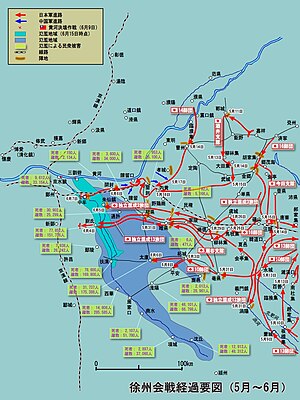Battle of Xuzhou
| Battle of Xuzhou | |||||||
|---|---|---|---|---|---|---|---|
| Part of the Second Sino-Japanese War | |||||||
 |
|||||||
|
|||||||
| Belligerents | |||||||
|
|
|
||||||
| Commanders and leaders | |||||||
|
|
|
||||||
| Units involved | |||||||
| Military regions 1 and 5 | |||||||
| Strength | |||||||
| 600,000 troops in 64 divisions | 240,000 troops in 8 divisions | ||||||
| Casualties and losses | |||||||
| 100,000 | 30,000 | ||||||
The Battle of Xuzhou was fought between Japanese and Chinese forces in May 1938 during the Second Sino-Japanese War. In contemporary accounts in English, the event was usually referred to as the "Battle of Hsuchow", using postal romanization.
In 1937, the North China Area Army had chased Song Zheyuan's 29th Army to the south along the Jinpu Railway (see Tianjin–Pukou Railway Operation) after his defeat in the Battle of Lugou Bridge. After Japan won the Battle of Nanjing, the North China Area Army advanced southward to establish a Japanese connection between Beijing and Nanjing, ignoring the non-expansionist policy of the Imperial General Headquarters in Tokyo. Most mechanized and air forces in Eastern China were wiped out in the Battle of Shanghai in 1937. Although new equipment was purchased, it had yet to be shipped. Han Fuqu, the chairman of the Shandong province, rejected orders from Chiang Kai-shek and kept retreating to preserve his force. After Qingdao was occupied in January 1938, his policy was denounced and he was executed on 24 January. In March 1938 Japanese forces occupied the north of Shandong, including the capital city Jinan. The defense line along the Yellow River was torn apart. Due to pressure from Japanese forces, 64 Chinese divisions gathered around Xuzhou in Jiangsu, the headquarters of 5th Military Region of the National Revolutionary Army. Without surrounding it, General Itagaki Seishiro moved south first to attack Tai'erzhuang, where he was defeated by Li Zongren in a regional asymmetric battle.
...
Wikipedia
